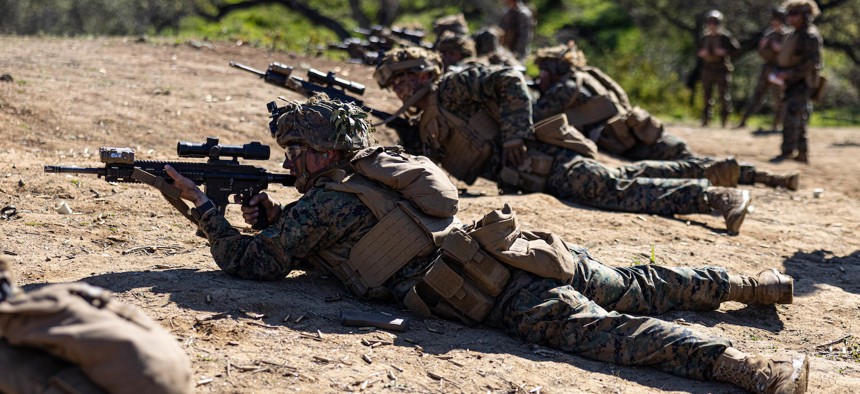
U.S. Marines with Infantry Marine Course 2-23, Infantry Training Battalion, School of Infantry-West, during a fire and maneuver range at Marine Corps Base Camp Pendleton, California, Jan. 24, 2023. U.S. Marine Corps / Cpl. Willow Marshall
Marines Will Restructure Infantry Battalions by September
The changes are informed by the service’s Infantry Battalion Experiment, part of Force Design 2030.
The Marine Corps will reconfigure all of its infantry battalions and shrink them from roughly 900 to just over 800 Marines by this fall as part of the service’s ongoing Force Design modernization effort.
The units will also have more medical and reconnaissance capabilities, as well as loitering munitions—changes that came out of the service’s Infantry Battalion Experiment as it prepares for future conflicts. The changes were announced Monday as part of the service's Force Design Annual Update.
The Marines in 2020 began the Infantry Battalion Experiment, or IBX, to see if they could rework infantry battalions to be smaller while at the same time having Marines trained to use a variety of weapons in a distributed environment. Commandant Gen. David Berger has said Force Design 2030 was necessary to get the force ready for potential operations in the Pacific and elsewhere.
The service used three existing battalions to test a variety of configurations, including one with just 735 Marines. During Phase I of the experimentation, which included 13 “live-force experiments” in different locations—they realized that was too small.
“We essentially broke the battalion. I mean, those are my words,” Lt. Gen. Karsten Heckl, the deputy commandant for Combat Development and Integration, told reporters Friday ahead of the update’s release. “But that's what we wanted, right? So we found our far left, left lateral limit, right? And then we came back. So we—the commandant made the decision to bring the infantry battalion number back up to 811.”
The Force Design update released Monday directs the deputy commandant for manpower and reserve affairs to “implement the 811 Marine battalion structure across all active and reserve component infantry units” by September 1.
This is the third and final update to the plan under Berger, who is retiring this summer. Berger has faced criticism from retired Marine leaders for some of the modernization effort’s major changes, but has also received support in Congress for the overhaul.
Despite critics saying that “we don’t listen,” Heckl said Berger “didn’t even balk” at the recommendation given by senior commanders to increase the size of the battalions from the proposed 735 level.
“This is what Marines do better than anybody,” he said. “We're small enough that we can be agile, and quick, and make changes quickly and efficiently. And that’s exactly what is happening here.”
The 811 number means battalions will be able to keep an entire 81-mm mortar section, instead of cutting it in half as would have been required with the 735 number, said Brig. Gen Kyle Ellison, the commander of the Marine Corps Warfighting Lab.
“The 81-mm mortar is an all-weather capable fire support asset for the battalion,” Ellison said. “Based on experimentation, what we determined was … some of our autonomous systems and loitering munitions that we're going to bring to bear here in the future aren’t all-weather. And so how do you create that complement of systems that enable us to maintain a combined-arms capable force at the battalion level?”
The redesigned battalions will also have a scout platoon that does “multidomain reconnaissance at the battalion level, being able to sense and make sense forward on a distributed battlefield,” a capability commanders currently do not have, Ellison said. Battalions will also have electronic warfare capabilities and loitering munitions at the company level, and more medical capabilities at the company and battalion level.
“We're going to be encountering a level—if we go to combat—a level of combat casualty care requirements that we haven't seen since World War II,” he said. “How are we going to keep faith with our people and be able to take care of them and evacuate them in a contested environment?”
The Marines settled on an 811-Marine battalion size last year, but also decided to keep experimenting and do a second phase of IBX, which Ellison calls the “decisive phase.” This phase is currently underway, focused on just 3rd Battalion, 4th Marines, based at Marine Corps Base Twentynine Palms in California.
The second phase “will be characterized by further refinements following a series of experiments at the company and battalion levels. These experiments will primarily focus on C5ISRT, sustainment, sensing, and lethality,” according to the new Force Design update. C5ISRT is command, control, computing, communications, cyber, intelligence, surveillance, reconnaissance, and targeting.
Third Battalion, 4th Marines returned from deployment in April, and over 18 months, as it prepares for the next one, the unit will be manned, trained, and equipped based on how the Marine Corps envisions future infantry battalions, “so we can assess it and build that body of evidence to make sure we found the sweet spot with our experimentation and our equipment,” Ellison said. The Marine Corps Warfighting Lab, which is leading the experimentation effort, will work with the unit through their training and deployment, he said.
“So we’re going to experiment with them in every clime and place, to include the jungles of Okinawa, Japan, and in the Pacific,” he said. “So it's about an 18 month experimentation timeline, but we'll recommend decisions as we learn. We're not going to wait to make decisions, there’s second- and third-order effects to every decision we make. And part of our responsibility is to inform Lt. Gen. Heckl of decisions that can be made early that help us anticipate later decisions or enable alternatives across the rest of the force.”
NEXT STORY: Pentagon Buying Musk’s Starlink for Ukraine




